In high-traffic areas, local governing authorities will often give advance notice regarding changes such as the opening of a new highway or interchange, the reconfiguration of a ramp or intersection, or a temporary construction detour over a new roadway or contraflow lane. With careful timing, Waze editors can proactively use this information to schedule routing changes in the area in order to minimize any potential disruptions to navigation. When a reconfiguration is simple enough not to significantly change routing, such as merely moving an exit a couple hundred feet, scheduling the change in WME is not necessary, and the map can simply be updated at the time of the change. However, when a reconfiguration is complex and significantly changes routing for a large number of people, it should be scheduled in advance. This article describes the procedure for implementing scheduled reconfigurations.

Draw new roads
More than two months from reconfiguration
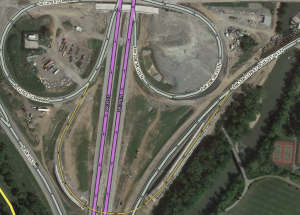
Road projects progress in stages through planning, design, earthwork, paving, painting and opening to traffic. Planned roads should not be mapped without any sign of their existence in the real world, but during the construction stages the alignment of future roads may become visible from aerial imagery. When this occurs the roads can be added to the map.
- Draw new roads as private roads so that they can be distinguished from complete, open roads on the map.
- Create them with the geometry, connections and turns that they are expected to have in their final configuration.
- Add time-based segment restrictions for all dates, times and vehicle types, in order to fully prevent routing.
- Where new road segments may create forks that trigger unnecessary turn instructions in either the old or new configurations, use turn instruction overrides to prevent instructions from being given.
- Where the new configuration overlaps the old configuration without a junction, set the new road segments temporarily to a higher elevation.
- If necessary, add a map comment to explain to other editors what is changing.
Less than two months from reconfiguration
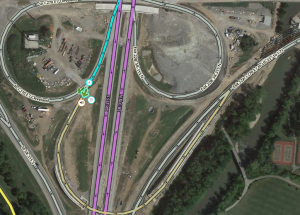
As the reconfiguration date approaches, or if the reconfiguration is announced with little prior notice, roads should be drawn with their correct type, and real-time closures should be added as soon as possible. Advance timing is necessary to allow for a tile update in order to use closures on any road segments with new IDs.
- Draw and connect any new roads that will be open after the reconfiguration, if they have not been created already during previous construction stages.
- Set the road type of any new roads to match their final configuration
- Make sure to allow all turns for both the old and new configurations.
- Use time-based segment restrictions on the new segments to prevent routing until closures can be added.
- Since the date may only be announced a few days in advance, there may only be time for one tile update from when the date is announced to when the reconfiguration occurs. Therefore, set the end date of the restriction to end the day before the opening day.
- Do not conversely place any time-based restrictions on any currently open roads that will be closed after the reconfiguration, in case the reconfiguration is postponed.
- As in the previous section, where new road segments may create forks that trigger unnecessary turn instructions in either the old or new configurations, use turn instruction overrides to prevent instructions from being given.
- If necessary, add a map comment to explain to other editors what is changing in the area.
Add real-time closures
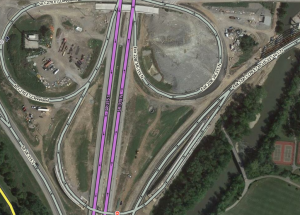
After a day or two, and before the change has occurred, check for a tile update. After the tile update, the new segment IDs will have been loaded into the closure database, and real-time closures can be added onto them.
Prevent new routes before reconfiguration
- Remove time-based restrictions from the new segments, which will be unnecessary once closures are set.
- Add closures to new segments from the present time until the expected time that the new route will be open.
- In order to minimize confusion for drivers, instead of closing all new segments, only close segments that are necessary to prevent routing.
- The end time will need to be adjusted if the time of the reconfiguration is changed.
Create an MTE and prevent unused routes after reconfiguration
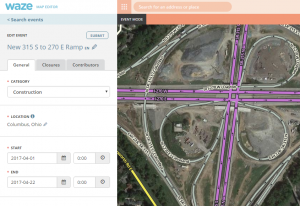

Also at this time, if the reconfiguration is still more than 48 hours away, create a major traffic event (MTE) for push messaging to drivers (if Waze determines that enough drivers are affected) and add future closures that will take effect after the reconfiguration under this event. If the reconfiguration will happen in less than 48 hours, there is no need to create an event for the future closures.
- If the reconfiguration is temporary, set the closures to end whenever traffic is expected to revert to normal, and repeat this step later before continuing to the last two steps, since the reversion will be its own traffic reconfiguration.
- If the reconfiguration is permanent, set the closures to end two weeks later. This will allow a cushion of time during which to finalize changes to the map.
Creating an event
- Zoom in on the location of the reconfiguration and switch WME to event mode from the matrix button in the top left corner of the screen.
- In the top right corner, click the "Add event" button.
- Name the new event according to the expected traffic change, e.g. "New I-xx to I-yy ramp," making sure the name is no longer than 25 characters so that it can be saved.
- Set the category to Construction and the location at the city and state where the change is occurring.
- Configure the time to start the day before the scheduled reconfiguration and to end after any future closures are expected to end. This is so that a push message will go to drivers just before the change happens, and the future closures can be added to the event. It is not possible to add closures to events if their times fall outside of the event start and end times.
- If the details of the reconfiguration or road project are available on a website, add the URL to the event.
- Click save, and return to default mode.
Adding closures and submitting the event
- Next, add the future closures, setting their start time according the time announced by the authority in charge of the project. Set their end time to the date of reversion, if temporary, or to two weeks later, if permanent. If the event has been properly configured and saved, once the dates and times for the closures are filled in, it can be selected as an option in the event field.
- Save the closures, and return to event mode. Select your event and click the Closures tab. If your closures have been added there, click the Submit button.
- If the event and its closures are submitted at least 48 hours before the event begins, the event will be reviewed by Waze staff, who will determine whether to send a push notification to drivers.
Add turn restrictions into/time-based restrictions on unused roads
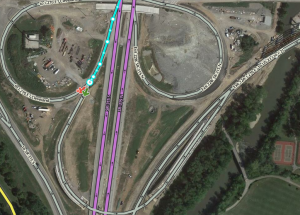
After the reconfiguration has occurred, restrict turns to any old roads that are no longer used. This will prevent routing after a tile update, even if the real-time closures on such roads are deleted or expire. This step is necessary, because closures must be maintained to prevent routing until the tile update.
Alternatively, remove the closures temporarily from unused roads, add time-based restrictions for all dates, times and vehicle types, then reinstate the closures. Make sure not to do any edits that change the segment IDs of the roads that will be deleted, so that closures can be reinstated.
Remove closures and clean decommissioned roads from the map
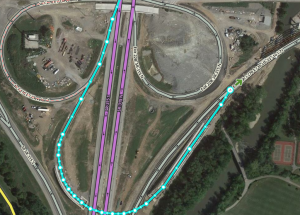
After a tile update puts the new restrictions into effect, it's time to clean up the map.
- Remove real-time closures on old roads.
- If any intersections are permanently blocked, such as when an interchange replaces an intersection, disconnect the roads that no longer route through the intersection.
- If any roads are currently unused but may be returned to use in the future, add time-based restrictions to them for all dates, times and vehicle types.
- If any roads are permanently closed and removed from service (decommissioned), never to return again to use, delete them from the map. Also delete unnecessary junction nodes and geometry handles.
- Remove any turn-instruction overrides that are no longer needed, and normalize any temporary elevation adjustments.
- After the new configuration has been in service for at least a week, check GPS tracks to see if the new traffic configuration is starting to be recorded, and use it to adjust alignment of the roads accordingly.
Roundabout
If a roundabout is part of a completely new set of roads, it can be built with the same process outlined above. However, if an existing intersection is being upgraded with a roundabout, the process will be a little different. For new roundabouts from existing intersections:
- Add necessary road closures during construction. If only the intersection is closed where the roundabout is being constructed, make a single two-way closure on the shortest segment connected to the intersection, and close the node at the intersection.
- Once road closures are active, restrict all turns represented by the closures and wait for a tile update.
- Build the roundabout according the section above, adding time-based restrictions to end sometime before its scheduled opening, and wait for a tile update.
- Add closures on the roundabout, scheduled to end when the roundabout opens, and remove the time-based restrictions. Attach these closures to an event in order to announce the imminent opening of the new roundabout.
A few notes:
- A new roundabout at an existing intersection is mapped after closures begin, since the creation of a roundabout deletes and/or disconnects roads inside it, making it difficult to preserve routing in the intersection before construction begins.
- Creation of a roundabout preserves the segment IDs of roads leading into it. Therefore, steps 2 and 3 can be combined in a quicker, slightly riskier process, by removing the construction closures at the roundabout, building the roundabout, then adding the closures back with an end time within 48 hours. After a tile update, the closures can be removed from the approach roads and applied to the roundabout (step 4).
- Only one tile update is necessary, so the process is quicker.
- There is a risk of people being routed through the closed intersection as the roundabout is being built in the editor, and there is another risk of a tile delay making it difficult to preserve closures.